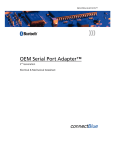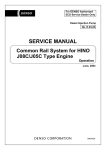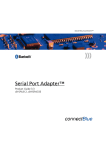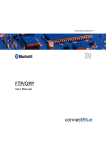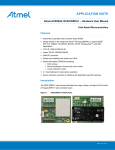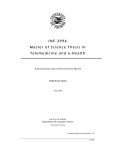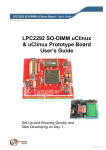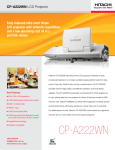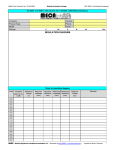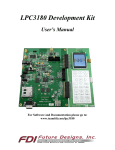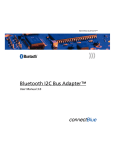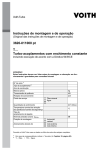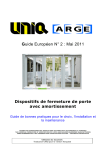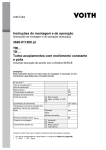Download OWSPA311G - Spezial Electronic
Transcript
INDUSTRIAL WIRELESS™ OWSPA311g i/x ™ cB-0908 Electrical & Mechanical Datasheet OWSPA311g i/x™ cB-0908 Electrical & Mechanical Datasheet Copyright © 2006-2008 connectBlue AB The contents of this document can be changed by connectBlue AB without prior notice and do not constitute any binding undertakings from connectBlue AB. connectBlue AB is not responsible under any circumstances for direct, indirect, unexpected damage or consequent damage that is caused by this document. All rights reserved. Release: 2008-09 Document version: 1.13 Document number: cBProduct-0611-04 (1) Printed in Sweden. Trademarks Registered trademarks from other companies are: Microsoft™, Windows™, Windows NT™, Windows 2000™, Windows CE™, Windows ME™, are registered trademarks from Microsoft Corporation. Contents 1 General Information 1.1 1.2 1.3 1.4 1.5 Overview ............................................................................................5 Related Documents ...........................................................................5 Product Variants ................................................................................6 OWSPA311g......................................................................................6 Block Diagram OWSPA311g .............................................................7 2 Electrical Interface and Connectors 2.1 2.2 2.3 2.4 5 8 Pin Numbering ...................................................................................9 Characteristics .................................................................................15 Hardware Reset ...............................................................................16 Power Control ..................................................................................16 3 Operating Status 17 4 Antenna Information 18 4.1 4.2 Surface Mounted Antenna (internal)................................................18 External Antennas............................................................................19 5 Mounting Information 5.1 5.2 5.3 5.4 5.5 Module Dimensions .........................................................................26 Using the J2/J3 Board-to-Board Connectors ...................................28 Using Press-Fit Nuts for Mounting the Module ................................29 Using the J6 PCB Solder Pads ........................................................29 Antenna Issues ................................................................................30 6 WLAN Information 6.1 36 General ........................................................................................36 Product Care....................................................................................36 Radio Frequency Exposure .............................................................36 Electronic Equipment .......................................................................37 Potentially Explosive Atmospheres..................................................37 Safety Compliance...........................................................................37 Appendix A A.1 A.2 A.3 32 Declaration of Conformity ................................................................32 IC and FCC Compliance for OWSPA311g ......................................33 UL Listing Information ......................................................................35 Compliance with RoHS directive .....................................................35 8 Guidelines for Efficient and Safe Use 8.1 8.2 8.3 8.4 8.5 8.6 31 General Information .........................................................................31 7 Regulatory Information 7.1 7.2 7.3 7.4 26 Application Notes 38 Step-by-Step Guide .........................................................................38 Design Examples .............................................................................39 A Complete 5V Host System Interface ............................................46 Version 1.13 - 2008-09 4 1 General Information 1.1 Overview The Serial Wireless LAN Module, OWSPA311g, from connectBlue has been developed for integration in industrial devices providing state of the art low power features. The module minimizes the work needed to implement WLAN (802.11b/g) in a device as it provides all software, hardware, type approval, EMC certification etc. It is developed for reliable, high demanding industrial devices and applications and requires no host driver. The Serial WLAN Module is a complete WLAN implementation. No external driver is needed. The WLAN module has a small form factor and the interface layout is the same as the Bluetooth modules from connectBlue, which enables customers to prepare their device for both Bluetooth and/or WLAN. • Supports both 802.11b and 802.11g • No software driver needed. • Radio type approved for Europe • Unlicensed Modular Transmitter Approval for US and Canada • Compliant with EMC standards • Industrial temperature range -30 to +85 C • Support for low power modes • Compatible with connectBlue Bluetooth modules • Supports security features WEP64, WEP128, WPA, WPA2, LEAP • Ad-hoc and infrastructure mode • Internal or dual external antennas (diversity supported) 1.2 Related Documents There are some documents related to the Serial Port Adapter: - The OWSPA AT Commands document contains a description of the AT commands supported in the OWSPA Serial Port Adapter. - The OWSPA Electrical & Mechanical Datasheet (this document) contains important information about the OWSPA Serial Port Adapter. Version 1.13 - 2008-09 5 1.3 Product Variants This Electrical and Mechanical datasheet contains information about the variants of OWSPA modules based on the PCB cB-0908 (see Table 1). Table 1: Product variants External antenna Internal antenna Product Name Module ID / FCC ID Description CB-OWSPA311gi-06 cB-0121-01 / PVH090802 OWSPA311g with internal antenna, JST connector CB-OWSPA311gi-04 cB-0120-01 / PVH090802 OWSPA311g with internal antenna, no JST connector CB-OWSPA311gx-06 cB-0123-01 / PVH090802 OWSPA311g with external antenna, JST connector. Receive diversity supported. CB-OWSPA311gx-04 cB-0122-01 / PVH090802 OWSPA311g with external antenna, no JST connector. Receive diversity supported. 1.4 OWSPA311g OWSPA311g is a small size Wireless LAN module based on the NXP BGW211 system in package (SiP) chip-set. The modules are available in many different antenna and connector combinations. See Picture 1 and 2 for some of the available models. All models are described in Table 1. Picture 1: cB-OWSPA311gx-06 OWSPA module with 2 external antennas and JST connector Version 1.13 - 2008-09 Picture 2: cB-OWSPA311gi-06 OWSPA module with internal antenna and JST connector 6 1.5 Block Diagram OWSPA311g Coaxial connectors J4 and J5 are only available on x-versions (eXternal antenna). Internal antenna A1 is only available on i-versions (Internal antenna). Figure 1: Block diagram of OWSPA311g Version 1.13 - 2008-09 7 2 Electrical Interface and Connectors This section describes the signals available on the module interface connectors. There are three ways of connecting to the OWSPA Module: • Via the PCB solder lands on the edge of the PCB, J6 (see Figure 5: Secondary side connectors). For more information see Section J6 Solder Lands Description. • Via the 2 x 20-pin 1mm pitch board-to-board (one piece part) connectors J2 and J3. The J2 and J3 connectors exist on the OWSPA module only as compression pads (see Figure 5: Secondary side connectors). These pads mates with the carrier board onepiece part connector. For more information see Section J2 Connector Description and J3 Connector Description. Optional: • Via the JST connector, J8 (see Figure 4: Primary side connectors). The connector is a 6 poles pin header. The pitch is 1mm and the connector is from JST with part number SM06B-SRSS-TB. For more information see section J8 Connector Description. Figure 2: Primary side of the PCB Version 1.13 - 2008-09 Figure 3: Secondary side of the PCB 8 2.1 Pin Numbering 2.1.1 Primary side connectors J8 is the JST connector located on the primary side of the module. A1 is the internal antenna. J4 and J5 are U.FL connectors for external antennas. J4 is the primary antenna connector and J5 the auxiliary antenna connector. Figure 4: Primary side connectors 2.1.2 Secondary side connectors J2 and J3 is the connectBlue board-to-board connector. The pin layout of the connector is compatible with all OEM Serial Port Adapters from connectBlue. The J6 is the solder land connector. Figure 5: Secondary side connectors Version 1.13 - 2008-09 9 2.1.3 J2 Connector Description Table 2: Signals on J2 J2 Pin Nr Pin Name Signal Level Type Description 1, 2 VSS Ground Power Ground (0 V) 3, 4 VDD 3.3V Power Supply voltage (3.3 – 5.5 VDC) 5 – 10 - - - Reserved, do not connect.[ 1 ] 11 RED/Mode[1,2] CMOS Out/In RED: Red LED control signal, low level = LED on (Output) Not valid until 500ms after power up. Mode: Not applicable to OWSPA311g 12 Switch-0[ 2 ] CMOS In Switch-0 control signal, active low. This signal activates the “Connect on external signal” function. See the Serial Port Adapter AT command specification for more information. 13 GREEN/ [2] Switch-1 CMOS Out/In GREEN: Green LED control signal, low level = LED on (Output) Not valid until 500ms after power up. Switch-1: [ 1, 4 ] during power up the unit If this pin is pulled-down reverts to default serial settings. The “Restore Default” input is only active during the first 500ms after power up. See the Serial Port Adapter AT command Specification for more information on the Restore switch. 14 BLUE[ 2 ] CMOS Out Blue LED control signal, low level = LED on (Output) Not valid until 500ms after power up. Note: Signal will flicker during data transmission. 15 UART-CTS[ 2 ] CMOS In Hardware flow control (Clear To Send). 16 UART-TxD[ 2 ] CMOS Out Transmit Data 17 UART-RTS[ 2 ] CMOS Out Hardware flow control (Request To Send). 18 UART-RxD[ 2 ] CMOS In Receive Data 19 UART-DTR[ 2 ] CMOS Out Data Terminal Ready 20 UART-DSR[ 2 ] CMOS In Data Set Ready [1] To remain compatible, please check the datasheet for other connectBlue products using this pin. [2] Signals are CMOS logic level. (- 0.3 V < VIL < 0.8 V, 2 < VIH < 3.3 V) [3] The ESD performance will be improved if this signal is decoupled with a 10 nF capacitor to VSS. [4] Choose a pull down resistor in the interval 1kΩ < R < 4.7kΩ, observe this is different to previous product generations from connectBlue. Version 1.13 - 2008-09 10 2.1.4 J3 Connector Description Table 3: Signals on J3 J3 Pin Nr Pin Name 1–8 Signal Level Type Description Reserved, do not connect[ 1 ] - 9 SerialSelect-0 [2] CMOS Out Control signal for external serial transceivers 10 SerialSelect-1 [2] CMOS Out Control signal for external serial transceivers 11 – 14 Reserved, do not connect - 15 PRI[ 2 ] CMOS In Bluetooth co-existence interface: Bluetooth high priority traffic indicator 16 BT[ 2 ] CMOS In Bluetooth co-existence interface: Bluetooth arbitration signal 17 WL[ 2 ] CMOS Out Bluetooth co-existence interface: WLAN arbitration signal 18 RX-IND[ 2 ] CMOS Out Bluetooth co-existence interface: WLAN receive indicator 19 RESETn[ 3 ] CMOS In Active low. Must be driven by open drain collector. 20 - Reserved, do not connect[ 1 ] [1] To remain compatible, please check the datasheet for other connectBlue products using this pin. [2] Signals are CMOS logic level. (- 0.3 V < VIL < 0.8 V, 2 < VIH < 3.3 V) [3] The ESD performance will be improved if this signal is decoupled with a 10 nF capacitor to VSS. Version 1.13 - 2008-09 11 2.1.5 J4 Primary External Antenna Connector J4 is the primary external antenna connector. It is used for both transmit and receive. The port impedance to match is 50Ω. Table 4: Signals on J4 J4 Pin Nr Pin Name Signal Level Type Description 1 AntMain RF I/O Primary external antenna port (50Ω) Note: this connector is only available on the CB-OWSPA311gx-02/04 2.1.6 J5 Auxiliary External Antenna Connector J5 is the auxiliary external antenna connector. It is used only for receiving and if the unit is configured for diversity mode. The unit never transmits RF through this antenna connector. The port impedance to match is 50Ω. Table 5: Signals on J5 J5 Pin Nr Pin Name Signal Level Type Description 1 AntAux RF I Auxiliary external antenna port (50Ω) Note: this connector is only available on the CB-OWSPA311gx-02/040 2.1.7 J8 Connector Description Tabel 6: Signals on J8 J8 Pin Nr Pin Name Signal Level Type Description 1 VSS 0V Power Ground (0 V) 2 VDD 3.3V Power Supply voltage (3.3 – 5.5 VDC) 3 UART-TxD[ 1 ] CMOS Out Transmit Data 4 UART-RxD [1] CMOS In Receive Data 5 UART-CTS [1] CMOS In Hardware flow control (Clear To Send). 6 UART-RTS[ 1 ] CMOS Out Hardware flow control (Request To Send). [1] UART signals are CMOS logic level (- 0.3 V < VIL < 0.9 V, 2.1 V < VIH < 3.3 V) Version 1.13 - 2008-09 12 2.1.8 J6 Solder Lands Description Table 7: Signals on J6 J6 Pin Nr Pin Name Signal Level Type Description 1 RESETn[ 3 ] CMOS In Active low. Must be driven by open drain collector. 2 UART-DSR[ 2 ] CMOS In Data Set Ready 3 VSS Ground Power Ground (0 V) 4 VDD 3.3V Power Supply voltage (3.3 – 5.5 VDC) 5 UART-DTR[ 2 ] CMOS Out Data Terminal Ready 6 RED/Mode[1,2] CMOS Out/In RED: Red LED control signal, low level = LED on (Output) Not valid until 500ms after power up Mode: Not applicable to OWSPA311g 7 GREEN/ [2] Switch-1 CMOS Out/In GREEN: Green LED control signal, low level = LED on (Output) Not valid until 500ms after power up. Switch-1: If this pin is pulled-down[ 1,4 ] during power up the unit reverts to default serial settings. The “Restore Default” input is only active during the first 500ms after power up. See the Serial Port Adapter AT command Specification for more information on the Restore switch. 8 BLUE[ 2 ] CMOS Out Blue LED control signal, low level = LED on (Output) Not valid until 500ms after power up. Note: Signal will flicker during data transmission. 9 UART-TxD[ 2 ] CMOS Out Transmit Data 10 UART-RxD[ 2 ] CMOS In Receive Data 11 UART-CTS[ 2 ] CMOS In Hardware flow control (Clear To Send). 12 UART-RTS[ 2 ] CMOS Out Hardware flow control (Request To Send). 13 PRI[ 2 ] CMOS In Bluetooth co-existence interface: Bluetooth high priority traffic indicator 14 BT[ 2 ] CMOS In Bluetooth co-existence interface: Bluetooth arbitration signal 15 WL[ 2 ] CMOS Out Bluetooth co-existence interface: WLAN arbitration signal Version 1.13 - 2008-09 13 J6 Pin Nr Pin Name Signal Level Type Description 16 RX-IND[ 2 ] CMOS Out Bluetooth co-existence interface: WLAN receive indicator Reserved, do not connect[ 1 ] 17 – 28 29 Switch-0[ 2 ] CMOS In 30 Switch-0 control signal, active low. This signal activates the “Connect on external signal” function. See the Serial Port Adapter AT command specification for more information Reserved, do not connect 31 SerialSelect-1 [2] CMOS Out Control signal for external serial transceivers 32 SerialSelect-0 [2] CMOS Out Control signal for external serial transceivers [1] To remain compatible, please check the datasheet for other connectBlue products using this pin. [2] Signals are CMOS logic level. (- 0.3 V < VIL < 0.8 V, 2 < VIH < 3.3 V) [3] The ESD performance will be improved if this signal is decoupled with a 10 nF capacitor to VSS. [4] Choose a pull down resistor in the interval 1k < R < 4.7k , observe this is different to previous product generations from connectBlue. Version 1.13 - 2008-09 14 2.2 Characteristics The OWSPA311g module is designed to be fully interchangeable with the connectBlue Bluetooth product range. If the host product has space for the board, it is possible to choose freely between Bluetooth modules, e.g. cB-OEMSPA311i/x or cB-OEMSPA331i/x, or WLAN modules, e.g. OWSPA311gi/x, without any change of the host product. If you design your power supply for cB-OWSPA311gi/x the modules will be fully interchangeable. 2.2.1 Power supply NOTE: Read the safety notes in section Guidelines for Efficient and Safe Use before using the modules. Table 8: Power supply Symbol Parameter Value VDD Supply voltage (Unregulated*) Unit Min 3.3 V Max 5.5 V * The module is equipped with voltage regulators. Table 9: Current consumption Symbol Power Mode State IDD @ VDD Reset pin low = 5V Sleep mode Online mode Stop mode Value Unit Average 0.40 mA Peak 400 mA Idle Average 4.0 mA Connected (dtim=5) Average 4.8 mA Connected (dtim=1) Average 7.4 mA Transmitting Average 130 mA Idle Average 4.0 mA Connected Average 143 mA Transmitting Average 143 mA Idle Average 0.57 mA 2.2.2 Input/Output signals Table 10: Input/output signals Symbol Parameter VIN Low Logic LOW level input voltage on all logic VIN High VOUT Low Value Logic HIGH level input voltage Logic LOW level output voltage Version 1.13 - 2008-09 Unit Min -0.3 V Max 0.8 V Min 2.0 V Max 3.3 V Max 0.4 V 15 VOUT High Logic HIGH level output voltage Min 2.6 V IGPIO Sink and source current Max 4 mA CGPIO Input capacitance Typ 5 pF Vthl(POR) Lower Power-on reset threshold voltage Typ 2.8 V Vthu(POR) Upper Power-on reset threshold voltage Typ 3.1 V 2.2.3 Environmental Table 11: Temperatures characteristics Parameter Product Variant Storage temperature Operating temperature Value Unit Min cB-OWSPA311g -40 °C Max cB-OWSPA311g +125 °C Min cB-OWSPA311g -30 °C Max cB-OWSPA311g +85 °C 2.3 Mechanical Table 12: Mechanical characteristics Parameter Product Variant Weight Value Unit Typ cB-OWSPA311gi-04 3.8 g Typ cB-OWSPA311gx-04 4.0 g 2.4 Hardware Reset A hardware-reset input, RESETn, is available on connector J3 and J6 (see section 2.1). An external reset source must be open drain. The RESETn pin is internally pulled-up to 1.5V with a resulting impedance of 5kΩ. It is recommended to decouple the RESETn pin externally with a 10nF capacitor. 2.5 Power Control The OWSPA Module can be put in one of three power modes. • Online mode – Minimum latency, maximum throughput. • Sleep mode – power saving. The adapter is held in low power mode and only listens and responds to beacons. • Stop mode – Maximum power save. The device is incapable of transmitting data. AT-commands are available for fine-tuning specific power consumption parameters. Version 1.13 - 2008-09 16 3 Operating Status The OWSPA311g module can be in different modes (see the Serial Port Adapter AT command Specification for more information about the modes) and the RED, GREEN and BLUE signals can be used to detect or indicating the status, see Table 13. The LED signals are active LOW. Table 13: Signal states in different module modes Serial Port Adapter Mode Status RGB LED Color GREEN GPIO BLUE GPIO RED GPIO Data mode IDLE Green LOW HIGH HIGH AT mode IDLE Orange LOW HIGH LOW Data mode, AT mode CONNECTING* Purple HIGH LOW LOW Data mode, AT mode CONNECTED* Blue HIGH LOW HIGH * On data activity the active LEDs flashes and will be HIGH for 50-100ms. For information on how to suppress the flashes see section A.2.3.1. DTR signal can be set to indicate an active WLAN link. For more information see Serial Port Adapter AT command Specification. Version 1.13 - 2008-09 17 4 Antenna Information There are 2 different antenna options available: • An internal surface mounted (SMD) antenna. • Two external U.FL antenna connectors. See section 5.1 for more information on antenna placement. This chapter gives an overview of the qualities of the different antenna options. 4.1 Surface Mounted Antenna (internal) The unit cannot be mounted in a metal-shielded enclosure with this antenna. Part Number OWSPA311gi Antenna name FR05-01-N Manufacture Fractus Polarization Linear Gain (Typ) 1.1 dBi Antenna Size (LxWxH) 6.7 x 6.7 x 1 mm Comment The antenna gain is dependent of the mounting of the module. See section 5.5 for mounting the module considering the antenna. Version 1.13 - 2008-09 18 4.2 External Antennas The external antennas are connected to the board via a U.FL connector. Some of the antennas are connected directly to the U.FL connector of the board and some are connected using an SMA connected through a short U.FL to SMA adapter cable. Note: Antennas with SMA connectors are not approved for use in USA or Canada due to FCC regulations. 4.2.1 Antenna Accessories Part Number cB-ACC-18 Name U.FL to SMA adapter cable Connector U.FL and SMA female Cable length 120 mm Cable loss Less than 0.5dBm Comment The SMA connector can be mounted in a panel. Approval Not to be used with modular approval in the US and Canada 4.2.2 Antennas Part Number Name NanoBlue-IP04 Manufacture CENTURION Type Patch antenna Polarization Vertical Gain +2 dBi Size 48 x 13 x 1 mm Connector U.FL (IPEX) Comment To be connected to the PCB U.FL connector. Approval Approved for use in the US and Canada Version 1.13 - 2008-09 19 Part Number cB-ACC-27 Name WCR-2400-IP04 Manufacture Centurion Type ½ wave dipole Polarization Vertical Gain +2.0dBi Size 108 mm (Straight) Connector U.FL (IPEX) Comment To be connected to the PCB U.FL connector. Approval Approved for use in the US and Canada Part Number cB-ACC-16 Name WCR-2400-SMA Manufacture Centurion Type ½ wave dipole Polarization Vertical Gain +2dBi Size 100 mm Connector SMA male Comment To be connected via the U.FL to SMA adapter cable. Approval Not to be used with modular approval in the US and Canada Version 1.13 - 2008-09 20 Part Number cB-ACC-17 Name Reel planTec Bluetooth m70 Manufacture Reel Type Patch Polarization Linear Gain +1dBi Size (∅xH) 75 x 20 mm Mounting M16 x 13.6 mm Cable length 3m Connector SMA male Other info Waterproof (IP67) Comment To be connected via the U.FL to SMA adapter cable. Approval Not to be used with modular approval in the US and Canada Part Number cB-ACC-23 Name PSTG0-2400HS Manufacture Mobile Mark Type ¼ wave dipole Polarization Vertical Gain 0 dBi Size 32 mm Connector SMA male Comment To be connected via the U.FL to SMA adapter cable. Approval Not to be used with modular approval in the US and Canada Version 1.13 - 2008-09 21 Part Number cB-ACC-21 Name Rugged SMA Manufacture Radiall/Larsen Type ½ wave dipole Polarization Vertical Gain 2 dBi Size Connector SMA male Comment To be connected via the U.FL to SMA adapter cable. Approval Not to be used with modular approval in the US and Canada Part Number Name IHF-242 Manufacture Joymax Type ¼ wave dipole Polarization Vertical Gain +2 dBi Size 82.5 mm Connector MCX male Comment To be connected via U.FL to MCX adapter cable Approval Not to be used with modular approval in the US and Canada Version 1.13 - 2008-09 22 Part Number Name IH-151 Manufacture Joymax Type ½ wave dipole Polarization Vertical Gain 5 dBi Size 196 mm Connector SMA male Comment To be connected via the U.FL to SMA adapter cable Approval Not to be used with modular approval in the US and Canada Version 1.13 - 2008-09 23 Part Number Name IG-103 Manufacture Joymax Type dipole Polarization Vertical Gain +9 dBi Size (∅xH) 24 x 621 mm Connector N-type Comment Approval Not to be used with modular approval in the US and Canada Part Number Name SPA 2400/75/8/0/V Manufacture HUBER+ SUHNER Type Patch Polarization Linear, Vertical Gain +7.5 dBi Size 101 x 80 x 20 mm Connector SMA female Comment To be connected via the U.FL to SMA adapter cable Approval Not to be used with modular approval in the US and Canada Version 1.13 - 2008-09 24 Part Number Name SOA 2400/360/6/0/V Manufacture HUBER+ SUHNER Type dipole Polarization Vertical Gain +6 dBi Size (∅xH) 22 x 250 mm Connector N-type Comment Approval Not to be used with modular approval in the US and Canada Part Number Name SOA 2400/360/4/20/V Manufacture HUBER+ SUHNER Type ¼ wave dipole Polarization Vertical Gain +4 dBi Size (∅xH) 86 x 43 mm Connector SMA male Comment To be connected via the U.FL to SMA adapter cable Approval Not to be used with modular approval in the US and Canada Version 1.13 - 2008-09 25 5 Mounting Information 5.1 Module Dimensions Figure 6: OWSPA311g primary side dimensions [mm] Figure 7 OWSPA311g profile dimensions [mm] Version 1.13 - 2008-09 26 5.1.1 Solder Lands dimensions Figure 8 OWSPA311g solder land dimensions [mm] 5.1.2 Mounting Holes There are 2 x 2.3mm mounting holes on cB-0908. The reasons for the 2.3mm holes are that the threaded M2 holes on the single and double row connectors (see section 5.2.1) are not aligned. The outer tangents of the 2.3mm holes align the module if the single row connectors are used and the inner if double row connectors are used (see Figure 9). Choose the outer tangent (CC distance 27.24mm) if the module is aligned and mounted with some other technique based on M2 screws (e.g. press-fit nuts), see Figure 10. Figure 9: The 2.3mm mounting holes [mm] Version 1.13 - 2008-09 27 5.2 Using the J2/J3 Board-to-Board Connectors The board-to-board connector should be a 1mm pitch one-piece part connector. The recommended manufacture is Samtec with many connector options available; see section 5.2.1.1. Chapter 2 contains more information about the connector and the electrical interface. 5.2.1 Suitable One-Piece Part Connectors 5.2.1.1 Double row ASP-118580-01 / ASP-118581-01 Connectors This connector is a double row connector and connects both J2 and J3. This connector has a height of 3.0mm and this has to be considered if components are to be mounted on the motherboard under the OWSPA module. The connector is also available with a height of 6.0mm and 10.0mm (The FSI-120 serie from Samtec). There are alignment pins on the bottom side of the connector. The connector is available with M2 threaded inserts ASP-118580-01) that fit the mounting holes on the board. You may screw the OWSPA module directly into these inserts. If you want to have a tighter and more secure mounting you may use longer screws and secure it using a nut on the backside of the motherboard. Another way to mount the module is to use press-fit nuts on the motherboard and skip the M2 threads on the connector (ASP-118581-01), see section 5.3 for more information about press-fit nuts. Table 14: Double row connectors from Samtec. Samtec order number Quote number Equivalent part Package Remark REF-120021-01 55392 FSI-120-03-G-D-AB Tube Align pin on bottom side only REF-120021-02 55392 FSI-120-03-G-D-AB-K-TR Tape-n-Reel Align pin on bottom side only REF-120018-01 55392 FSI-120-03-G-D-M-AB Tube With M2 threaded inserts and align pin on bottom side only REF-120018-02 55392 FSI-120-03-G-D-M-AB-K-TR Tape-n-Reel With M2 threaded inserts and align pin on bottom side only NOTE: When ordering connectors from Samtec or an official Samtec distributor, please use the REF order number and refer to the connectBlue global quote number for best price. For technical questions regarding the Samtec connectors please contact connectBlue or Samtec at ([email protected]). See Figure 10 for more information about the connector and necessary measurements on the motherboard. The large mounting holes on the motherboard are designed for press-fit nuts and could be smaller if press-fit nuts are not used. Version 1.13 - 2008-09 28 Figure 10: Host PCB layout [mm] for double row connector. 5.3 Using Press-Fit Nuts for Mounting the Module A press-fit nut is pressed into the PCB from the bottom side with a special press tool. M2 sized press-fit nuts are suitable for the modules (see Figure 10) and are manufactured by PEM Fastening Systems (www.pemnet.com), part no KFS2-M2 (see Figure 11). Be careful with the distance between the nuts regarding alignment. Figure 11: KFS2-M2 press-fit nut. It is recommended to use spacers between the two PCB’s when press-fit nuts are used. 5.4 Using the J6 PCB Solder Pads 5.4.1 Host PCB In order to avoid short circuit with traces/vias on the module the host PCB footprint should not contain any traces or vias under the module except the pads interfacing the J6 pads. The host pads which are soldered to the J6 pads should reach 0.5-1.0mm under the PCB and some mm outside the module. No other pads than the J6 should be soldered to the host PCB. For detailed information about the signals present on the solder lands See section J6 Solder Lands Description. Version 1.13 - 2008-09 29 5.4.2 Mounting process • We strongly recommend the modules not being soldered more than 1 time after shipping from connectBlue and that the modules are mounted just before the host product is being soldered the last time. Although, connectBlue devices will withstand up to two reflows to an absolute maximum temperature of 250°C. • The PCB in our modules is made of FR4-type with Chemical Gold Pads. • The modules are produced in a lead-free process with a lead-free soldering paste. • It is recommended that the customers make their own electrical, climate, stress and vibration tests on the final assembled product to secure that the manufacturing process hasn't damaged or affected the OWSPA module in any way. • The modules can be delivered on trays or individually packed in ESD bags with label on each module. The label will not withstand the heat of soldering and should be removed before processed. The modules delivered in trays will not have individual label (only batch labels on the tray). • Modules delivered on trays are classed with MSL-Class 3. • The device recommended maximum reflow temperature is 245°C for 10 sec. • The device absolute maximum reflow temperature is 250°C for 3 sec. 5.5 Antenna Issues The unit cannot be mounted arbitrary, because of the radio communication. A unit with an internal surface mounted antenna, cB-OWSPA311gi, cannot be mounted in a metal enclosure. No metal enclosure or plastics using metal flakes should be used, also avoid metallic based paint or lacquer. There must be a keep-out volume 10 mm in each direction around the antenna free from PCBtraces, PCB-vias, components or other conducting material. If a metal enclosure is required, one of the external antenna options has to be used. See section 4.2 for more information on the antenna options available. Version 1.13 - 2008-09 30 6 WLAN Information 6.1 General Information In the table below you can find information about module WLAN properties. Table 15: WLAN information OWSPA311g Parameter Data Radio Phillips BGW211 (SA2459 + SA5253) RF output power 802.11b mode: +17 dBm 802.11g mode: +17 dBm (6 – 36 Mbit/s) +15 dBm (48 – 54 Mbit/s) Receiver sensitivity, mode 802.11b mode 802.11g Data rate (PER< 10%) 1 Mbit/s -94 dBm 11 Mbit/s -87 dBm 6 Mbit/s - 89 dBm 9 Mbit/s - 88 dBm 12 Mbit/s - 86 dBm 18 Mbit/s - 85 dBm 24 Mbit/s - 82 dBm 36 Mbit/s - 78 dBm 48 Mbit/s - 74 dBm 54 Mbit/s - 72 dBm Receive input level (max) -10 dBm Output frequency 2.412 –2.472 GHz (channel 1 – 13, 5MHz separation) WiFi Certified Bluetooth coexistence Version 1.13 - 2008-09 31 7 Regulatory Information 7.1 Declaration of Conformity We, connectBlue AB, of Norra Vallgatan 64 3V SE-211 22 Malmö, Sweden declare under our sole responsibility that our products: cB-OWSPA311gi (cB-0120-01, cB-0121-01), cB-OWSPA311gx (cB-0122-01, cB-0123-01) to which this declaration relates, conforms to the following product specifications: R&TTE Directive 1999/5/EC EN 300 328 EMC Directive: 89/336/EEC EN 301 489-1 EN 301 489-17 EN 61000-6-2 Safety Compliance st EN 60950-1:2001 and/or IEC 60950-1:2001 (1 Edition) EN 60950-1/A11:2004 + Corrigendum:2004 23/03/2007 Malmö, Sweden Mats Andersson CTO of connectBlue AB If a cB-OWSPA311g i/x is used within EU a notification may be necessary to be made to each of the national authorities responsible for radio spectrum management of the intention to place radio equipment that uses frequency bands whose use is not harmonized throughout the EU, on its national market. More information at: http://europa.eu.int/comm/enterprise/rtte/gener.htm Version 1.13 - 2008-09 32 7.2 IC and FCC Compliance for OWSPA311g See Table 1 for information about the different product variants. 7.2.1 IC Compliance Operation is subject to the following two conditions: (1) this device may not cause harmful interference, and (2) this device must accept any interference received, including interference that may cause undesired operation. This device has been designed to operate with an antenna having a maximum gain of 9dBi. Having a higher gain is strictly prohibited per regulations of Industry Canada. The required antenna impedance is 50 ohms. To reduce potential radio interference to other users, the antenna type and its gain should be so chosen that the equivalent isotropic radiated power (EIRP) is not more than that required for successful communication. The installer of this radio equipment must ensure that the antenna is located or pointed such that it does not emit RF field in excess of Health Canada limits for the general population; consult Safety Code 6, obtainable from Health Canada’s website www.hc-sc.gc.ca/rpb. 7.2.2 FCC Statement for OWSPA311g This device complies with Part 15 of the FCC Rules. Operation is subject to the following two conditions: (1) this device may not cause harmful interference, and (2) this device must accept any interference received, including interference that may cause undesired operation. NOTE: This equipment has been tested and found to comply with the limits for a Class B digital device, pursuant to Part 15 of the FCC Rules. These limits are designed to provide reasonable protection against harmful interference in a residential installation. This equipment generates, uses and can radiate radio frequency energy and, if not installed and used in accordance with the instructions, may cause harmful interference to radio communications. However, there is no guarantee that interference will not occur in a particular installation. If this equipment does cause harmful interference to radio or television reception, which can be determined by turning the equipment off and on, the user is encouraged to try to correct the interference by one or more of the following measures: • Reorient or relocate the receiving antenna • Increase the separation between the equipment and receiver • Connect the equipment into an outlet on a circuit different from that to which the receiver is connected Consult the dealer or an experienced radio/TV technician for help 7.2.3 Antenna Our module type OWSPA311g is for OEM integrations only. In the end-user product the module shall be professionally installed in such a manner that only the authorized antennas can be used. Version 1.13 - 2008-09 33 7.2.4 Caution Any changes or modifications NOT explicitly APPROVED by connectBlue AB could cause the module to cease to comply with FCC rules part 15, and thus void the user’s authority to operate the equipment. 7.2.4.1 Ad-hoc mode frequencies Our module type OWSPA311g when operating under the definition of a client in 47 CFR §15.202 is preconfigured to use the most restrictive regulatory domain. For this reason the available operating frequency range is limited to channel 1 – 11 (2412 – 2462 MHz). If the regulatory domain of the module for any reason is changed it may cause operation on illegal frequencies and as a result the module will cease to comply with FCC rules part 15, and thus void the user’s authority to operate the equipment. 7.2.5 Labeling Requirements for End Product For an end product using the product OWSPA311g there MUST be a label containing, at least, the following information: This device contains FCC ID: PVH090802 IC: 5325A-090802 The label must be affixed on an exterior surface of the end product such that it will be visible upon inspection in compliance with the modular approval guidelines developed by the FCC. In accordance with 47 CFR § 15.19 the end product shall bear the following statement in a conspicuous location on the device: “This device complies with Part 15 of the FCC Rules. Operation is subject to the following two conditions: (1) this device may not cause harmful interference, and (2) this device must accept any interference received, including interference that may cause undesired operation.” When the device is so small or for such use that it is not practicable to place the statement above on it, the information shall be placed in a prominent location in the instruction manual or pamphlet supplied to the user or, alternatively, shall be placed on the container in which the device is marketed. However, the FCC ID label must be displayed on the device. In case, where the final product will be installed in locations where the end-consumer is not able to see the FCC ID and/or this statement, the FCC ID and the statement shall also be included in the end-product manual. 7.2.6 RF-exposure Statement for OWSPA311g This modular transmitter MUST have a separation distance of at least 20 cm between the antenna and the body of the user or nearby persons. If the radio module is installed in a laptop display, transmission MUST be prevented if the lid is closed to ensure that the minimum distance of 20 cm between the user and the transmitting antenna is maintained. Any notification to the end user of installation or removal instructions about the integrated radio module is NOT allowed. Version 1.13 - 2008-09 34 7.3 UL Listing Information If a customer intends to UL list a product including the OWSPA311g based on the PCB cB-090802 this information is useful: The printed circuit board if produced according to the following specification: • UL recognized ZPMV2 min. 130 °C flame class V-0 or better. 7.4 Compliance with RoHS directive The OWSPA311g are produced according to the RoHS (Restriction of the use of certain Hazardous Substances in electrical and electronic equipment) directive and complies with the directive. Version 1.13 - 2008-09 35 8 Guidelines for Efficient and Safe Use 8.1 General Read this information before using your OWSPA311g module. For any exceptions, due to national requirements or limitations, when using your OWSPA311g module, please contact connectBlue AB. Note: Changes or modifications to the product not expressly approved by connectBlue AB will void the user’s authority to operate the equipment. 8.2 Product Care • Do not expose your product to liquid or moisture. • Do not expose you product to extreme hot or cold temperature (see Section 2.2.3 for further information) • Do not expose your product to lit candles, cigarettes, cigars, open flames, etc. • Do not drop, throw or try to bend your product since rough treatment could damage your product. • Do not attempt to disassemble your product. Doing so will void warranty. The product does not contain consumer serviceable or replaceable components. Service should only be performed by connectBlue AB. • Do not paint your product as the paint could prevent normal use. • If you will not be using your product for a while, store it in a place that is dry, free from damp, dust and extreme heat and cold. • The clearance and creepage distances required by the end product must be withheld when the module is installed. • The cooling of the end product shall not negatively be influenced by the installation of the module when the module is installed. 8.3 Radio Frequency Exposure The OWSPA311g module contains a small radio transmitter and receiver. During communication with other WLAN products the OWSPA311g module receives and transmits radio frequency (RF) electromagnetic fields (microwaves) in the frequency range 2400 to 2480 MHz. The output power of the radio transmitter is very low. When using the OWSPA311g module, you will be exposed to some of the transmitted RF energy. This exposure is well below the prescribed limits in all national and international RF safety standards and regulations. Version 1.13 - 2008-09 36 8.4 Electronic Equipment Most modern electronic equipment, for example, in hospitals and cars, is shielded from RF energy. However, certain electronic equipment is not. Therefore: Note: This equipment emits RF energy in the ISM (Industrial, Scientific, Medical) band. Please insure that all medical devices used in proximity to this device meet appropriate susceptibility specifications for this type of RF energy. 8.5 Potentially Explosive Atmospheres Turn off your electronic device before entering an area with potentially explosive atmosphere. It is rare, but your electronic device could generate sparks. Sparks in such areas could cause an explosion or fire resulting in bodily injury or even death. Areas with a potentially explosive atmosphere are often, but not always, clearly marked. They include fuelling areas, such as petrol station, below deck on boats, fuel or chemical transfer or storage facilities, and areas where the air contains chemicals or particles, such as grain, dust, or metal powders. 8.6 Safety Compliance In order to fulfill the safety standard EN 60950-1:2001 the OWSPA311g must be supplied by a class-2 Limited Power Source. 8.6.1 Power Supply • Connect your power supply only to designated power-sources as marked on the product. • Make sure all cords and cable are positioned so that they will not be stepped on, tripped over or otherwise subject to damage or stress. • To reduce risk of electric shock, unplug the unit from any power source before attempting to clean it. Version 1.13 - 2008-09 37 Appendix A - Application Notes Usually only a subset of the available functionality is of interest to the designer. In addition, depending on the host system, the electrical interface can be designed in many ways. The designer can use the step-by-step guide in this chapter as an aid in the design process. A.1 Step-by-Step Guide Table 16: Step-by-step guide with Yes and No answers. Question Yes No Are you going to integrate the OWSPA The internal antenna models canSerial Port Adapter in a metal enclonot be used. Use the OWsure? SPA311gx You are free to choose between the products. The internal antenna models are lower cost and are easier to design-in. However, an external antenna could give better range. Do you wish to use logic level when communicating with the Serial Port Adapter? See section A.2.2.1 for electrical design. See section A.2.2.2 for electrical design. Do you want to use RS232 as the physical serial interface? See section A.2.2.2 for electrical design. Go on to next point. Do you want to use RS485 or RS422 as the physical serial interface? TDB Go on to next point. Is low power consumption important? TBD Go on to next point. Do you wish to connect LEDs to the Serial Port Adapter? See section A.2.3 for design exam- Go on to next point. ples for connecting the LEDs. Do you want to detect the status of the module with a controller? See Chapter 3 for status detection and section A.2.3 for electrical design. Go on to next point. Do you wish to utilize the restore switch? See section A.2.3.2 for electrical design. Go on to next point. Do you wish to utilize the Function See section A.2.3.4 for electrical switch (“Connect on external signal”)? design. Go on to next point. Do you want to manually reset the module? See section A.2.4 for electrical design. Use a double row connector. See section 5.2.1.1. Version 1.13 - 2008-09 38 A.2 Design Examples This section contains design examples for all interfaces on connectors J2, J3, J6 and J8. The connector type that suits a specific application depends on the needed signal and the preferred interface type (wires, board-to-board or SMD). A.2.1 Logic Levels A 3.3V host system can be connected directly to the logic level pins (BLUE, UART-TxD / UARTRxD etc). A serial 100Ω resistor shall be used (see Figure 12) for protection, see Table 10 for logic levels characteristics. A 5V host system can easily be adjusted to the logic levels. A host system output signal can use a resistive divider (18k/22k) to adjust the levels. This is applicable for speeds up to 115.2kBits/s. The divider can be adjusted to 1.8k/2.2k and a logic buffer (74HCT08) for higher speeds (see Figure 13). The host system input pins could require a buffer (see Figure 13) depending on the logic level requirements (see Table 10). The 74HCT08 gate is also available in a single gate package (74AHCT1G08). Figure 12: Logic levels interface to a 3.3V system. A protective 100Ω resistor is used. Figure 13: Interface example with logic levels to a 5V system. A 5V system with open collector outputs is designed in Figure 14. Figure 14: Open collector outputs. Version 1.13 - 2008-09 39 A.2.2 Serial Interface The serial interface of the module use logic levels and the module can be connected to an external CPU (see section A.2.2.1). An external driver is needed if the module should be on another physical interface like RS232 (see section A.2.2.2). CTS (Clear To Send) and RTS (Request To Send) are used for hardware flow control. DSR (Data Set Ready) can be used to make a connect attempt. See the Serial Port Adapter AT commands specification. DTR (Data Terminal Ready) can be used to detect if the module is up and running and ready to receive data. Note! The module must be configured to flow control none if hardware flow control is not used, see the Serial Port Adapter AT Command Specification Manual. A.2.2.1 Logic level Mode The serial UART interface can be used in a host controller application with a UART interface. The design of the interface depends on the power supply voltage of the host system; see Figure 15 for a 3.3V host system and Figure 16 for a 5V host system. Figure 15: A complete UART interface with a 3.3V host system. Figure 16: A complete UART interface with a 5V host system. Version 1.13 - 2008-09 40 A.2.2.2 External RS232 driver An external RS232 driver is needed if the module should have a RS232 serial interface. See Figure 17 for a complete design example that could be connected to the serial port of standard PC. Pins providing functionality not used can be left unconnected. Figure 17: A complete RS232 interface. A.2.3 LED and Switch Design A.2.3.1 BLUE Signal The BLUE logic LED signal is not multiplexed with any other functionality. See Figure 18 for an example on how to use the pin. There are two important notes: - A blue LED requires about 3.5V forward voltage drop (cannot be used in a 3.3V system). Version 1.13 - 2008-09 41 - The BLUE signal can be used to detect if the module is connected or not. The BLUE signal flashes when the module is sending and receiving data (see Chapter 3, Table 13). See Figure 19 for an example on how to suppress the flashes. Figure 18: A blue LED can be connected directly to the module if the LED current is below 4mA. A high state (active low) makes the voltage drop over the LED to 2.2V. This is not enough to light the LED. Figure 19: A Low pass filter and a 74HC08 suppress the flashes when the module is sending and receiving data. The Blue LED can be removed if not required. The values are not suited in all applications and need to be verified in a specific application. A.2.3.2 RED Signal The RED logic LED signal is not multiplexed with any other functionality. See Figure 20 for a 3.3V design. In a 5V system the high state output (2.9V) from the module is not enough to turn off the LED so a 74HCT08 buffer can be used to raise the high level to 5V (see Figure 21). The 74HCT08 gate is available in a single gate package (74AHCT1G08). Version 1.13 - 2008-09 42 Figure 20: A red LED in a 3.3V host system. The status of the signal can also be used as input to a host controller. Figure 21: A red LED in a 5V host system. The status of the signal can also be used as input to a host controller. For connectBlue products with internal RS232 driver, the RED signal pin is also used to select Logic Level mode instead of RS232. The mode selection functionality is not applicable on OWSPA311g because there is no internal RS232 driver available. To be compatible with these products check the datasheet about this signal. A.2.3.3 GREEN/Switch-1 signal The GREEN/Switch-1 signal is a multiplexed signal: - GREEN - Logic green LED signal (see Chapter 3, Table 13). Becomes valid 500ms after start up. - Switch-1 - The module reads the status of the signal at startup to decide if the serial interface settings shall be restored (LOW) (see the Serial Port Adapter User Manual for more details). The input signal must be stable for the first 500ms after startup (after reset/power on reset). The signal is internally pulled-up (15kΩ) to 3.0V for NOT restoring settings to default. Note! The internal 15kΩ pull-up is smaller than on previous product generations from connectBlue. This requires a smaller pull-down resistor (1kΩ) for a low state. If a LED is used and a switch is required to be able to restore the settings, a high impendence buffer need to prevent the signal from being pulled-up via the LED. A 74HC08 logic gate can be used in a 3.3V system (see Figure 22) and a 74HCT08 logic gate in a 5V system (see Figure 23). Both gates are available in a single gate package (74AHC1G08/74AHCT1G08). Sometimes, over time, switch contacts can get an oxide layer. This may cause the closed switch resistance to become too high to sink the signal to logic LOW (the signal is internally pulled-up to 15kΩ). A design that prevents this can be found in Figure 27. Figure 22: Switch-1 used together with a green LED in a 3.3V host system. The status of the signal can also be used as input to a host controller. Notice the 1kΩ serial resistor. Figure 23: Switch-1 used together with a green LED in a 5V host system. The status of the signal can also be used as input to a host controller. Notice the 1kΩ serial resistor. Version 1.13 - 2008-09 43 The buffer can be removed in a 3.3V system if no restore switch is required (see Figure 24). In a 5V system the high state output (2.9V) from the module is not enough to turn off the LED, so a 74HCT08 buffer can be used to raise the high level to 5V (see Figure 25). The 74HCT08 gate is also available in a single gate package (74AHCT1G08). Figure 24: No restore switch used but a green LED in a 3.3V host system. The status of the signal can also be used as input to a host controller. Figure 25: No restore switch used but a green LED in a 5V host system. The status of the signal can also be used as input to a host controller. A serial resistor to the restore switch must be used to prevent a short circuit when the GREEN/Switch-1 pin is in output HIGH state and the switch is pressed (see Figure 26). The GREEN/Switch-1 pin can be left unconnected if none of its functionality is required. Figure 26: A low resistance restore switch used. Notice the 1kΩ serial resistor. Figure 27: If the resistance in the switch is not guaranteed to be low enough, a safer design can be used. Notice the 1kΩ serial resistor. A.2.3.4 Switch-0 Signal Switch-0 is not multiplexed with other functionality and a switch is easily implemented (see Figure 28). Sometimes, over time, switch contacts can get an oxide layer. This may cause the closed switch resistance to become too high to sink the signal to logic LOW (the signal is internally pulled-up to 15kΩ). A design that prevents this can be found in Figure 29. The Switch-0 pin can be left unconnected if its functionality is not used. Version 1.13 - 2008-09 44 Figure 28: used. A low resistance function switch Figure 29: If the resistance in the switch is not guaranteed to be low enough, a safer design can be used. A.2.4 Reset The RESET pin can be connected to an external reset source, see Figure 30 for a switch example. If the reset signal is connected to an output signal it must be an open drain, see Figure 31. The RESET pin can be left unconnected if not used. Figure 30: A reset switch. Figure 31: Design of an open collector reset from an active high output. Version 1.13 - 2008-09 45 A.3 A Complete 5V Host System Interface This is a complete 5V host system interface example with an RGB LED and two switches (except the serial interface, see section A.2.2 for information). The design is based on the LM339 Quad OP-amp instead of logic gates. Figure 32: A complete 5V host interface with operational amplifier Version 1.13 - 2008-09 46















































